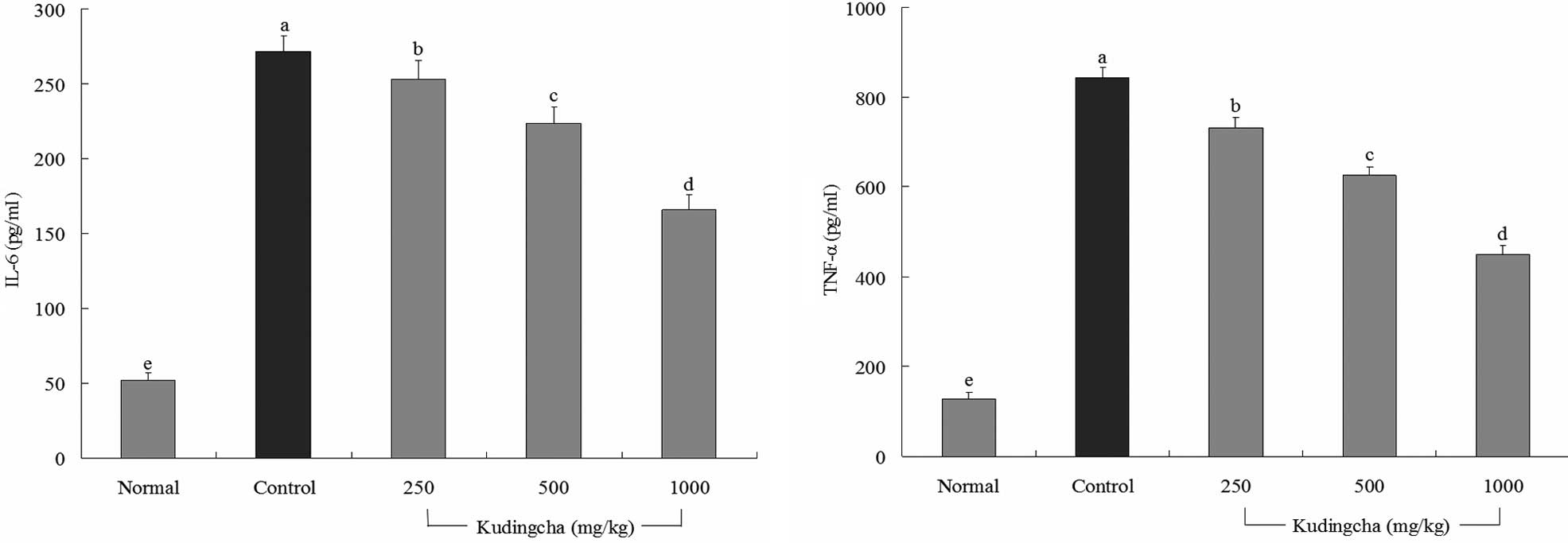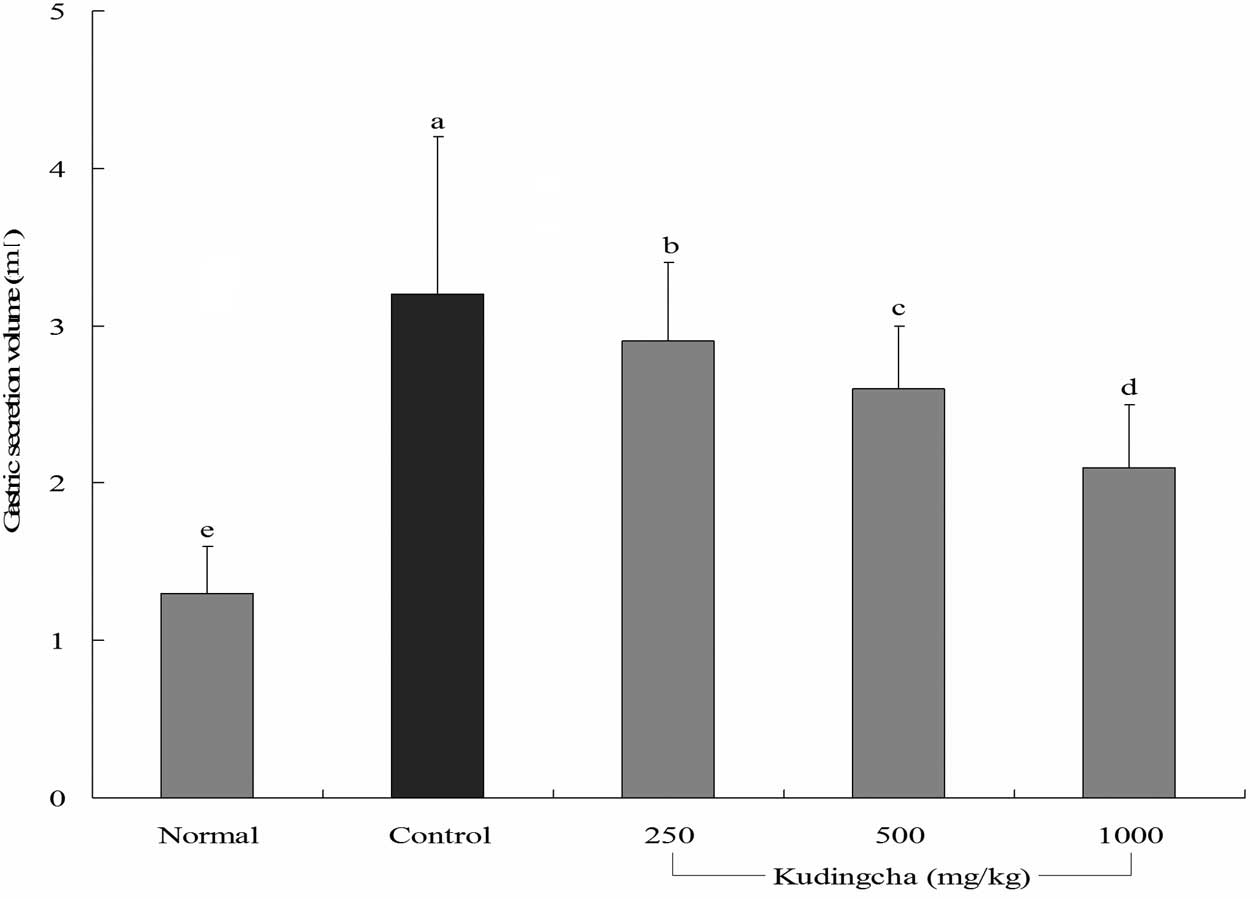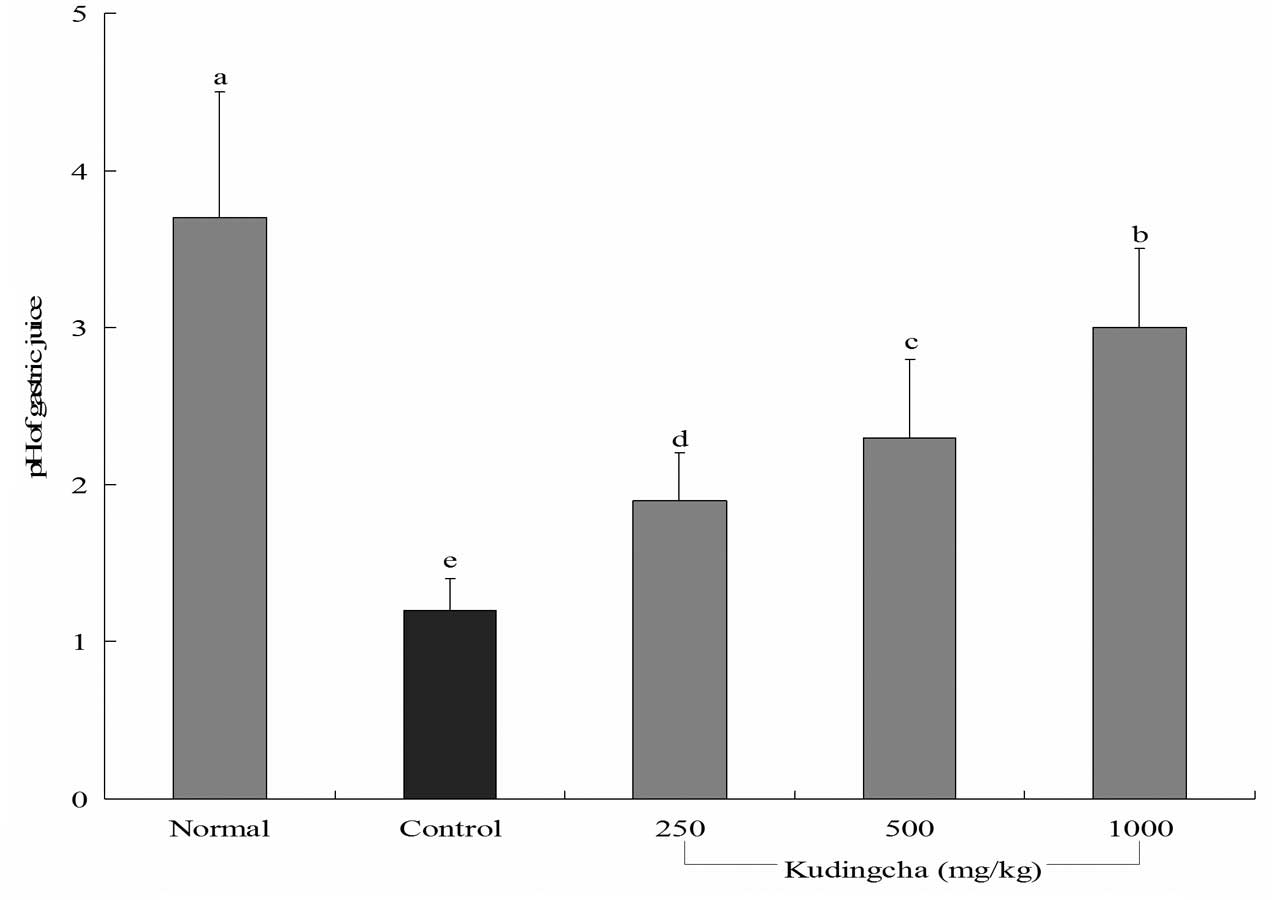Ilex kudingcha C.J. Tseng (Kudingcha) prevents HCl/ethanol‑induced gastric injury in Sprague‑Dawley rats
- Authors:
- Published online on: March 28, 2013 https://doi.org/10.3892/mmr.2013.1402
- Pages: 1613-1616
Abstract
Introduction
Ilex kudingcha C.J. Tseng (kudingcha) is one of the main plants utilized in kuding production, a bitter tea of Chinese origin, which is traditionally consumed in East Asia (1). Previous studies have analyzed its chemical composition and pharmaceutical functions (2) and it has been reported that kudingcha is rich in polyphenolic compounds and demonstrates potent antioxidant activities in vitro(3,4). In addition, the major phenolic compounds of kudingcha have been identified as caffeoylquinic acid (CQA) derivatives, natural functional compounds isolated from a variety of plants which possess a broad range of pharmacological properties, including antioxidant, hepatoprotectant, antibacterial, antihistaminic, anticancer, neuroprotective and other biological effects (5,6).
Gastric injury is an injury to the stomach. Trauma may be blunt or penetrating and involve damage to the abdominal organs. Ethanol promotes the rapid formation of injuries in the stomach, which occurs mainly due to an inflammatory reaction (7). Ethanol-induced gastric injury is characterized by epithelial cellular loss, mucosal edema and subepithelial hemorrhage (8). Cytokines, including interleukin 6 (IL-6) and tumor necrosis factor-α (TNF-α), are small proteins that are produced and released from a number of cells under physiological and pathological conditions (9). IL-6 is becoming increasingly recognized as an almost ubiquitous participant in numerous types of inflammatory processes (10). TNF-α is a macrophage-derived cytokine with chemotactic potency, which has been implicated in the acute phase reaction under various inflammatory conditions (11).
In the present study, the preventive effects of kudingcha on gastric injury were examined. Levels of inflammatory cytokines, IL-6 and TNF-α, were analyzed to determine the preventative effects of kudingcha on HCl/ethanol-induced gastric injury in Sprague-Dawley (SD) rats. In addition, gastric injury levels, gastric secretion volumes and the pH of gastric juice were determined when various concentrations of kudingcha were applied.
Materials and methods
Preparation of kudingcha
Kudingcha was purchased from Hainan Yexian Biological Technology Co., Ltd. (Chongqing, China), stored at −80°C and freeze-dried to produce a powder. A 20-fold volume of boiling water was added to the powdered sample and extracted twice. The water extract was evaporated using a rotary evaporator (Eyela N-1100; Tokyo Rikakikai Co., Ltd., Tokyo, Japan), concentrated and then dissolved in dimethylsulfoxide (Amresco LLC, Solon, OH, USA) to adjust to the stock concentration (20%, w/v).
Animals
Male SD rats (n=50; age, 7 weeks) were purchased from the Experimental Animal Center of Chongqing Medical University (Chongqing, China) and maintained in a temperature-controlled (25±2°C; relative humidity, 50±5%) facility with a 12-h light/dark cycle and access to standard rat chow and water ad libitum.
Gastric injury experiment
The normal and control groups received 14-day repeated oral administration of distilled water and a single dose of vehicle [2 ml/kg (body weight) of olive oil, per os], while the sample groups received 14-day repeated oral administration of 250, 500 or 1,000 mg/kg kudingcha extract. Next, the control and sample groups of rats were administered 1 ml HCl/ethanol (60% in 150 mM HCl) per os via esophageal intubation and sacrificed after 1 h under deep ether anesthesia. Stomachs were removed, inflated by injecting 10 ml 1% formalin for 10 min to fix the tissue walls and opened along the greater curvature. The area (mm2) of hemorrhagic lesions developed in the stomach was determined under a digital camera (D550, Canon, Tokyo, Japan) using a square grid and the images were analyzed by ImageJ software. Gastric juice pH was measured using a pH meter (SevenEasy pH; Mettler-Toledo, Schwerzenbach, Switzerland) following a 10-times dilution. These experiments followed a protocol approved by the Animal Ethics Committee of Chongqing Medical University (Chongqing, China).
Analysis of inflammatory cytokines in serum using ELISA
For serum cytokine assays, blood from the inferior vena cava was collected into a tube and centrifuged (730 × g; 10 min; 4°C). The IL-6 and TNF-α levels in serum was aspirated and assayed as described below. The concentration of the inflammatory cytokines, IL-6 and TNF-α, in the serum was measured using ELISA according to the manufacturer’s instructions (BioLegend, Inc., San Diego, CA, USA). Briefly, biotinylated antibody reagent was added to 96-well plates and the supernatants of homogenized serum were incubated at 37°C in CO2 for 2 h. Following washing with PBS, streptavidin-peroxidase solution was added and the plate was incubated for 30 min at room temperature. The absorbance was measured at 450 nm using a microplate reader (iMark, Bio-Rad, Hercules, CA, USA) (12).
Statistical analysis
Data are presented as the mean ± SD. Differences between the mean values for individual groups were assessed by one-way ANOVA with Duncan’s multiple range test. P<0.05 was considered to indicate a statistically significant difference. SAS version 9.1 (SAS Institute Inc., Cary, NC, USA) was used for statistical analysis.
Results
Inflammatory cytokine levels in serum
The IL-6 level in normal rats was 52.1±4.5 pg/ml; however, that of control rats was significantly increased to 271.2±10.2 pg/ml. Levels of IL-6 in rats fed with 250, 500 and 1,000 mg/kg kudingcha were 253.2±12.3, 223.6±10.8 and 165.7±10.2 pg/ml, respectively (Fig. 1). TNF-α levels in normal, control and 250, 500 and 1,000 mg/kg kudingcha-treated rats were 127.5±14.6, 843.3±22.2, 732.1±22.2, 625.7±18.6 and 448.9±20.6 pg/ml, respectively. Serum IL-6 and TNF-α levels in rats of the kudingcha-treated groups were identified to be significantly lower than those in the control group. Reductions in IL-6 and TNF-α levels following treatment with 1,000 mg/kg kudingcha were 48.2 and 55.1%, respectively, compared with the control group.
Gastric injury levels
Kudingcha administration to rats with gastritis led to reduced gastric injury. The gastric injury level in control rats was 14.2±3.4 mm2. Rats treated with 250 and 500 mg/kg kudingcha revealed a gastric injury inhibitory rate of 19.0 (gastric injury, 11.5±3.2 mm2) and 63.4% (gastric injury, 5.2±2.1 mm2), respectively, and 1,000 mg/kg kudingcha (inhibitory rate, 73.9%; gastric injury, 3.7±1.4 mm2) was found to exhibit the strongest effect for the prevention of gastritis (Table I, Fig. 2). These results demonstrated that kudingcha had a marked preventive effect on gastric injury.
Gastric secretion volume and gastric juice pH
Gastric secretion volumes in normal, control and 250, 500 and 1,000 mg/kg kudingcha-treated rats were 1.3±0.3, 3.2±1.0, 2.9±0.5, 2.6±0.4 and 2.1±0.4 ml, respectively (Fig. 3). The pH values of gastric juices were calculated as 3.7±0.8, 1.2±0.2, 1.9±0.3, 2.3±0.5 and 3.0±0.5, respectively (Fig. 4). These observations demonstrated that kudingcha-treated rats exhibited a reduced gastric secretion volume and higher pH compared with the control rats.
Discussion
Although kudingcha has been used as a traditional beverage, limited scientific studies have been performed to determine its effects. Kudingcha has high concentrations of amino acids, vitamins, polyphenols, flavonoids and caffeine (13), and has been previously reported to have various therapeutic effects on pathological conditions, including inflammation, diabetes and cancer (14).
Levels of serum cytokines, including IL-6, TNF-α, IL-1β and IFN-γ, in patients with inflammatory diseases are higher than those in healthy individuals (15). Thus, lower levels of IL-6 and TNF-α are indicative of improved anti-inflammatory effects. In the present study, kudingcha was identified to exhibit a protective effect on gastric damage. IL-6 is an interleukin that functions as a proinflammatory and an anti-inflammatory cytokine, and is encoded by the IL6 gene in humans (16). IL-6 is secreted by T cells and macrophages to stimulate an immune response, particularly during tissue damage, which leads to inflammation. IL-6 is also known to play a role in fighting infection (17). TNF-α is a cytokine involved in systemic inflammation and is a member of a group of cytokines that stimulate the acute phase reaction. The primary role of TNF is the regulation of immune cells. As an endogenous pyrogen, TNF induces fever, apoptotic cell death, sepsis (via IL-1 and IL-6 production), cachexia and inflammation and inhibits tumorigenesis and viral replication (18). Inflammatory cytokines, IL-6 and TNF-α, play a pathogenic role in diseases of the stomach (19). Although systemic IL-6 levels are elevated following traumatic hemorrhage, hepatocellular function is impaired and gastric injury occurs (20). TNF-α has also been identified as a key mediator in a number of experimental stomach injury models (21).
A highly acidic environment in the stomach is an important marker of gastric injury; gastric injury causes a raise of gastric secretion volume and acid output, with significantly decreased gastric pH (22). Low acidity is caused by a deficiency in kudingcha. In the present study, kudingcha was found to exhibit a preventive effect on gastric injury by increasing levels of stomach acid.
The current study demonstrated that kudingcha was an effective agent for the prevention of HCl/ethanol-induced gastric injury in SD rats. Our results indicated that the protective effects of kudingcha may be due to decreased levels of proinflammatory cytokines, including IL-6 and TNF-α. Analysis of the stomachs of various rat treatment groups revealed that kudingcha prevented HCl/ethanol-induced abdominal injury, indicating that kudingcha represents a potentially useful agent for the treatment or prevention of chemical-induced gastric injury in vivo.
Acknowledgements
This study was Supported by Natural Science Foundation Project of CQ CSTC (No. CSTC2012jjA80002) and Supported by Science and Technology Research Project of Chongqing Municipal Education Commission (No. KJ121504)
References
|
Sun Y, Xu WQ, Zhang WQ, Hu QH and Zeng XX: Optimizing the extraction of phenolic antioxidants from kudingcha made from Ilex kudingcha C.J. Tseng by using response surface methodology. Sep Purif Technol. 78:311–320. 2011. View Article : Google Scholar | |
|
Bravo L, Goya L and Lecumberri E: LC/MS characterization of phenolic constituents of mate (Ilex paraguariensis, St. Hil) and its antioxidant activity compared to commonly consumed beverages. Food Res Int. 40:393–405. 2007. | |
|
Filip R, López P, Giberti G, Coussio J and Ferraro G: Phenolic compounds in seven South American Ilex species. Fitoterapia. 72:774–778. 2001. View Article : Google Scholar : PubMed/NCBI | |
|
Nakajima Y, Shimazawa M, Mishima S and Hara H: Water extract of propolis and its main constituents, caffeoylquinic acid derivatives, exert neuroprotective effects via antioxidant actions. Life Sci. 80:370–377. 2007. View Article : Google Scholar | |
|
Han J, Miyamae Y, Shigemori H and Isoda H: Neuroprotective effect of 3,5-di-O-caffeoylquinic acid on SH-SY5Y cells and senescence-accelerated-prone mice 8 through the up-regulation of phosphoglycerate kinase-1. Neuroscience. 169:1039–1045. 2010. View Article : Google Scholar : PubMed/NCBI | |
|
Szabo S, Trier JS, Brown A and Schnoor J: Early vascular injury and increased vascular permeability in gastric mucosal injury caused by ethanol in the rat. Gastroenterology. 88:228–236. 1985. View Article : Google Scholar : PubMed/NCBI | |
|
Medeiros JV, Gadelha GG, Lima SJ, Garcia JA, Soares PM, Santos AA, Brito GA, Ribeiro RA and Souza MH: Role of the NO/cGMP/K(ATP) pathway in the protective effects of sildenafil against ethanol-induced gastric damage in rats. Br J Pharmacol. 153:721–727. 2008. View Article : Google Scholar : PubMed/NCBI | |
|
Ramadori G and Armbrust T: Cytokines in the liver. Eur J Gastroenterol Hepatol. 13:777–784. 2001. View Article : Google Scholar : PubMed/NCBI | |
|
McCurry KR, Campbell DA Jr, Scales WE, Warren JS and Remick DG: Tumor necrosis factor, interleukin 6, and the acute phase response following hepatic ischemia/reperfusion. J Surg Res. 55:49–54. 1993. View Article : Google Scholar : PubMed/NCBI | |
|
Ming WJ, Bersani L and Mantovani A: Tumor necrosis factor is chemotactic for monocytes and polymorphonuclear leukocytes. J Immunol. 138:1469–1474. 1987.PubMed/NCBI | |
|
Park HS, Park JY and Yu R: Relationship of obesity and visceral adiposity with serum concentrations of CRP, TNF-α and IL-6. Diabetes Res Clin Pract. 69:29–35. 2005. | |
|
Wang WL and Wang SJ: Healthcare effects and development prospects of Ilex kudingcha. Beverage Ind. 11:12–13. 2008.(In Chinese). | |
|
Wang Z, Meng TB, Mei SM and Xiao CY: The biological characteristics of Malus sieboldfi(Rege1) Rehd - Kudingcha and its exploitation. Guiding J TCM. 12:90–91. 2006.(In Chinese). | |
|
Gratacós J, Collado A, Filella X, Sanmartí R, Cañete J, Llena J, Molina R, Ballesta A and Muñoz-Gómez J: Serum cytokines (IL-6, TNF-α, IL-1β and IFN-γ) in ankylosing spondylitis: a close correlation between serum IL-6 and disease activity and severity. Br J Rheumatol. 33:927–931. 1994. | |
|
Ferguson-Smith AC, Chen YF, Newman MS, May LT, Sehgal PB and Ruddle FH: Regional localization of the interferon-beta 2/B-cell stimulatory factor 2/hepatocyte stimulating factor gene to human chromosome 7p15–p21. Genomics. 2:203–208. 1988.PubMed/NCBI | |
|
van der Poll T, Keogh CV, Guirao X, Buurman WA, Kopf M and Lowry SF: Interleukin-6 gene-deficient mice show impaired defense against pneumococcal pneumonia. J Infect Dis. 176:439–444. 1997.PubMed/NCBI | |
|
Gosselin D and Rivest S: Role of IL-1 and TNF in the brain: twenty years of progress on a Dr. Jekyll/Mr Hyde duality of the innate immune system. Brain Behav Immun. 21:281–289. 2007.PubMed/NCBI | |
|
Abdollahi H, Shams S, Zahedi MJ, Darvish Moghadam S, Hayatbakhsh MM and Jafarzadeh A: IL-10, TNF-α and IFN-γ levels in serum and stomach mucosa of Helicobacter pylori-infected patients. Iran J Allergy Asthma Immunol. 10:267–271. 2011. | |
|
Gislason H, Røkke O and Svanes K: Release of cytokines associated with gastric mucosal injury. Eur Surg Res. 28:278–286. 1996. View Article : Google Scholar : PubMed/NCBI | |
|
Kuzuhara T, Suganuma M, Oka K and Fujiki H: DNA-binding activity of TNF-alpha inducing protein from Helicobacter pylori. Biochem Biophys Res Commun. 362:805–810. 2007. View Article : Google Scholar : PubMed/NCBI | |
|
Ku CS and Mun SP: Antioxidant activities of ethanol extracts from seeds in fresh Bokbunja (Rubus coreanus Miq.) and wine processing waste. Bioresour Technol. 99:4503–4509. 2008. View Article : Google Scholar : PubMed/NCBI |













